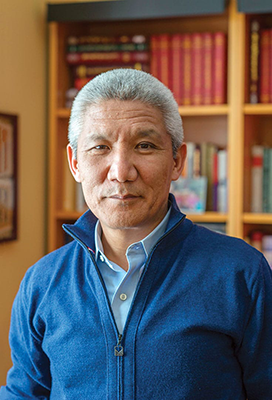
Defining Features of Mind Training
In this short clip, Thupten Jinpa provides a rich explanation of some of the key characteristics specific to mind training teachings, including the centrality of the mind, the focus on combating self-cherishing, the uncomplicated structure and system, and the emphasis on radical everyday mindfulness. We hope you enjoy this short clip from the Mind Training course, part of Jinpa’s acclaimed Bodhisattva Path online course series.
About the Teacher
 Thupten Jinpa was educated in the classical Tibetan monastic academia and received the highest academic degree of Geshe Lharam (equivalent to a doctorate in divinity). Jinpa also holds a BA in philosophy and a PhD in religious studies, both from the University of Cambridge, England. Since 1985, he has been the principal translator to the Dalai Lama, accompanying him to the United States, Canada, and Europe. He has translated and edited many books by the Dalai Lama, including The World of Tibetan Buddhism, Essence of the Heart Sutra, and the New York Times bestseller Ethics for the New Millennium. Jinpa has published scholarly articles on various aspects of Tibetan culture, Buddhism, and philosophy, and books such as Songs of Spiritual Experience: Tibetan Poems of Awakening and Insight (co-authored) and Self, Reality and Reason in Tibetan Thought. He serves on the advisory board of numerous educational and cultural organizations in North America, Europe, and India. He is currently the president and the editor-in-chief of the Institute of Tibetan Classics, a nonprofit educational organization dedicated to translating key Tibetan classics into contemporary languages. And he also currently chairs the Mind and Life Institute and the Compassion Institute.
Thupten Jinpa was educated in the classical Tibetan monastic academia and received the highest academic degree of Geshe Lharam (equivalent to a doctorate in divinity). Jinpa also holds a BA in philosophy and a PhD in religious studies, both from the University of Cambridge, England. Since 1985, he has been the principal translator to the Dalai Lama, accompanying him to the United States, Canada, and Europe. He has translated and edited many books by the Dalai Lama, including The World of Tibetan Buddhism, Essence of the Heart Sutra, and the New York Times bestseller Ethics for the New Millennium. Jinpa has published scholarly articles on various aspects of Tibetan culture, Buddhism, and philosophy, and books such as Songs of Spiritual Experience: Tibetan Poems of Awakening and Insight (co-authored) and Self, Reality and Reason in Tibetan Thought. He serves on the advisory board of numerous educational and cultural organizations in North America, Europe, and India. He is currently the president and the editor-in-chief of the Institute of Tibetan Classics, a nonprofit educational organization dedicated to translating key Tibetan classics into contemporary languages. And he also currently chairs the Mind and Life Institute and the Compassion Institute.
About the Lineage
Atiśa Dīpaṃkara (982–1054) was a famed scholar and teacher from the Indian monastic university of Vikramalaśīla and played a key role in the proliferation of the mind training teachings in Tibet.
Serlingpa (circa 10th c.) was a Buddhist scholar of great stature who resided in Sumatra (mordern-day Indonesia). He was an incredibly dear teacher and lojong instructor for Atiśa, who repeatedly proclaimed that whatever degree of good heart he possessed was due entirely to Serlingpa.
Dharmarakṣita (circa 10th c.) was a yogi and prominent lojong teacher of Atiśa. He was said to have upheld Vaibhāṣika tenets and possessed compassion so great that he once cut off a piece of his own flesh and gave it to a sick man as medicine.
Maitrīyogi, or Kusalī Jr. (circa 10th), was a dedicated yogi of Maitreya and important mind training teacher of Atiśa. He was reportedly a proponent of the lineage of first equalizing and then exchanging self and others when meditating on the awakening mind.
Dromtönpa (1005–1064) was Atiśa’s principal disciple, a highly influential lay practitioner and lineage lama, and a notable propagator of the mind training teachings.
Potowa (1027–1105) was one of three important disciples of Dromtönpa, receiving the full written works (tib. gzhung) transmission from his teacher and passing these and other teachings onto his key students Langri Tangpa and Sharawa.
Langri Tangpa (1054–1123) was one of the most influential teachings in the early lojong tradition and is particularly renowned for his highly concise and accessible composition The Eight Verses of Mind Training.
Sharawa (1070–1141) was a disciple of Potowa and a notable holder of the mind training lineage of teachings. He transmitted Atisha’s Root Verses of Mind Training to his student Chekawa.
Chekawa (1102–1176) an important propagator of the mind training teacher and one of the first teachers, if not the first, to present the key elements of Atiśa’s mind training instructions in terms of seven key points.
